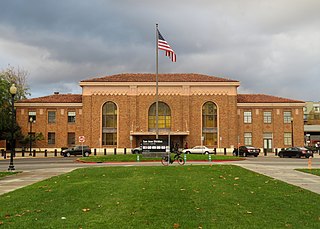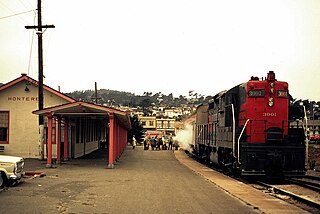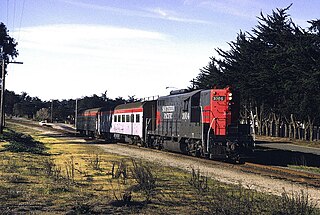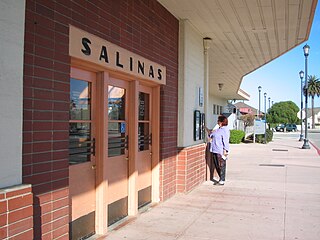
Caltrain is a California commuter rail line serving the San Francisco Peninsula and Santa Clara Valley. The southern terminus is in San Jose at Tamien station with weekday rush hour service running as far as Gilroy. The northern terminus of the line is in San Francisco at 4th and King Streets. Caltrain has 28 regular stops, one limited-service weekday-only stop, one weekend-only stop (Broadway), and one football-only stop (Stanford). While average weekday ridership in 2019 exceeded 63,000, impacts of the COVID-19 pandemic have been significant: in August 2022, Caltrain had an average weekday ridership of 18,600 passengers.

The Pacific Surfliner is a 350-mile (560 km) passenger train service serving the communities on the coast of Southern California between San Diego and San Luis Obispo.

The Capitol Corridor is a 168-mile (270 km) passenger train route in Northern California operated by Amtrak between San Jose, in the Bay Area, and Auburn, in the Sacramento Valley. The route is named after the two points most trains operate between, San Jose and Sacramento. The route runs roughly parallel to Interstate 880 and Interstate 80. Some trips run from Oakland to San Jose, while a single daily round trip runs all the way from San Jose to Auburn, in the foothills of the Sierra Nevada. Capitol Corridor trains started in 1991.

The San Joaquins is a passenger train service operated by Amtrak in California's San Joaquin Valley. Six daily round trips run between its southern terminus at Bakersfield and Stockton, with onward service to Sacramento and Oakland.

The Coast Starlight is a passenger train operated by Amtrak on the West Coast of the United States between Seattle and Los Angeles via Portland and the San Francisco Bay Area. The train, which has operated continuously since Amtrak's formation in 1971, was the first to offer direct service between Seattle and Los Angeles. Its name is a combination of two prior Southern Pacific (SP) trains, the Coast Daylight and the Starlight.

Amtrak California is a brand name used by the California Department of Transportation (Caltrans) Division of Rail for three state-supported Amtrak commuter rail routes in California – the Capitol Corridor, the Pacific Surfliner, and the San Joaquins – and their associated connecting network of Thruway Motorcoach buses.

The Coast Daylight, originally known as the Daylight Limited, was a passenger train on the Southern Pacific Railroad (SP) between Los Angeles and San Francisco, California, via SP's Coast Line. It was advertised as the "most beautiful passenger train in the world," carrying a particular red, orange, and black color scheme. The train operated from 1937 until 1974, one of the few passenger trains retained by Amtrak in 1971. Amtrak merged it with the Coast Starlight in 1974.

The Spirit of California was a passenger train operated by Amtrak between Los Angeles and Sacramento, California. It operated from 1981 to 1983 with financial support from the State of California. It was the first overnight service between the two cities since the Southern Pacific Railroad discontinued the Lark in 1968 and one of few state-supported Amtrak trains with sleeper service. The train used the Southern Pacific's Coast Line, complementing the Coast Starlight which served the route on a daytime schedule.

The establishment of America's transcontinental rail lines securely linked California to the rest of the country, and the far-reaching transportation systems that grew out of them during the century that followed contributed to the state's social, political, and economic development. When California was admitted as a state to the United States in 1850, and for nearly two decades thereafter, it was in many ways isolated, an outpost on the Pacific, until the First Transcontinental Railroad was completed in 1869.

San Jose Diridon station is the central passenger rail depot for San Jose, California. It also serves as a major intermodal transit center for Santa Clara County and Silicon Valley. The station is named after former Santa Clara County Supervisor Rod Diridon.

Monterey–Salinas Transit (MST) is a bus service operating in Monterey County, California. Service is primarily to the greater Monterey and Salinas areas, but extends as far south as Paso Robles and Big Sur and as far north as Watsonville and San Jose. Most lines follow a hub-and-spoke system, connecting at hubs in Monterey or Salinas. In 2021, the system had a ridership of 1,690,400, or about 5,700 per weekday as of the second quarter of 2022.

The Peninsula Commute, also known as the Southern Pacific Peninsula or just Peninsula, was the common name for commuter rail service between San Jose, California and San Francisco, California on the San Francisco Peninsula. This service ran as a private, for-profit enterprise beginning in 1863. Due to operating losses, the Southern Pacific Railroad (SP) petitioned to discontinue the service in 1977. Subsidies were provided through the California Department of Transportation (Caltrans) in 1980 to continue service, and it was renamed Caltrain.

Gilroy station is a Caltrain station located in Gilroy, California, United States. It is the southernmost terminus of the Caltrain system, and is only served during weekday rush hours in the peak direction, with trains going toward San Francisco in the morning and returning southbound in the evening. The station building was constructed by the Southern Pacific Railroad in 1913 and restored in 1998. Future plans call for extended Amtrak Capitol Corridor service to also stop at Gilroy. The station was named to the National Register of Historic Places in 2019 as Gilroy Southern Pacific Railroad Depot.

The San Joaquin Daylight was a Southern Pacific passenger train inaugurated between Los Angeles and San Francisco's Oakland Pier by way of the San Joaquin Valley and Tehachapi Pass on July 4, 1941. Travel times were between 12 hours (1970) and 14 hours (1944). It operated until the advent of Amtrak in 1971.

The Third and Townsend Depot was the main train station in the city of San Francisco for much of the first three quarters of the 20th century. The station at Third Street and Townsend Street served as the northern terminus for Southern Pacific's Peninsula Commute line between San Francisco and San Jose and long-distance trains between San Francisco and Los Angeles via the Southern Pacific's Coast Line. For service for destinations to the north, such as Seattle, and destinations to the east, such as Chicago, passengers generally needed to travel to Oakland, initially on ferries to Oakland Long Wharf, and later on buses to 16th Street Station. It was demolished in the 1970s and replaced by the Caltrain commuter station a block away at Fourth and King Streets.

The Suntan Special was a summer excursion train service operated by the Southern Pacific Railroad between San Francisco and Santa Cruz, California, from 1927 to 1959.

Monterey station was a train station in Monterey, California located close to Fisherman's Wharf. Originally served by the Monterey & Salinas Valley Railroad, the line was purchased by Southern Pacific on September 29, 1879. Southern Pacific constructed a new station building in 1921. Train service ended with the cancellation of the Del Monte after April 30, 1971, when Amtrak took over passenger rail services in the United States.

The Monterey Branch Line is a railway line located in Monterey County, California. It runs 16 miles (26 km) between Castroville, where it connects to the Union Pacific Coast Line, and Monterey, formerly running as far as Pacific Grove. It is roughly paralleled by California State Route 1 and is active to Sand City as of 2020.

The Monterey County Rail Extension is a planned commuter rail extension that would bring Caltrain passenger service south of its existing Gilroy, California terminus to Salinas in Monterey County, using the existing Coast Line owned by Union Pacific (UPRR). Implementation of the rail extension will occur over three phases, starting from Salinas and moving north. When construction is complete, there will be four trains operated over the extended line per weekday: two northbound trains that depart from Salinas and travel to San Francisco in the morning, and two southbound trains that return to Salinas in the afternoon.























